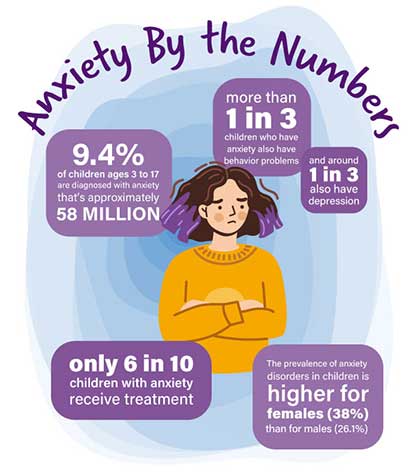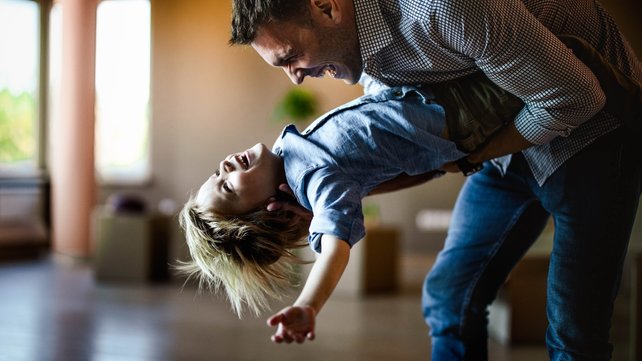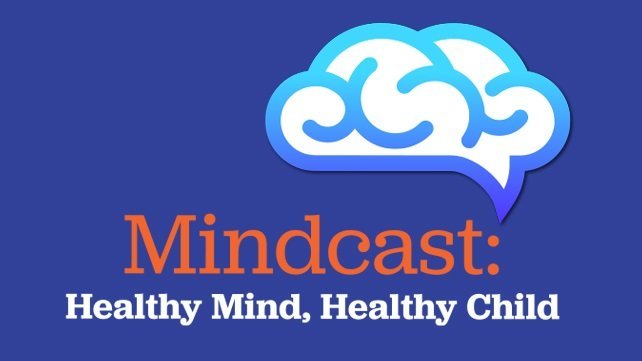Anxious and…
How would you finish that phrase? Anxiety is not one-word-fits-all. You can be anxious and fearless. Anxious and brave. Anxious and worthy. Anxiety is more than one word. And you are more than your anxiety.
It’s normal for children to feel worried or nervous from time to time. Starting school, moving to a new area, performing in a game or recital - these are all situations where a normal level of anxiety can actually be a healthy part of a child’s development. But when anxiety begins to affect a child’s daily thoughts and behaviors, and interfere with their home, school, and social life, it may be more serious.
Addressing your child’s anxiety early is key. If left untreated, anxiety can worsen and allow other mental health conditions to develop. Knowing the signs of anxiety in children, being aware of changes in your child’s behaviors and moods, and knowing how to get treatment for them can minimize any future complications and mental health challenges.
At Bradley Hospital, we offer varying levels of care, different treatment options, and a range of programs, in order to best treat each child’s individual needs, goals, and concerns.

Anxiety by the Numbers
Diagnoses of anxiety become more common with increased age.
The number of diagnoses of anxiety in children has increased over time.
Research shows that adolescents with untreated anxiety are at higher risk to perform poorly in school and engage in substance abuse.
- Almost 10% of 3- to 17-year-old children are diagnosed with anxiety. That’s approximately 5.8 million.
- For children between 13 and 18 years old, 31.9% are affected by anxiety.
- More than one in three children who have anxiety also have behavior problems and around one in three also have depression.
- The prevalence of anxiety disorders in children is higher for females (38%) than for males (26.1%).
- Among children between 3 and 17 years old, only 6 in 10 children with anxiety receive treatment.
Signs and Symptoms of Anxiety in Children
Anxiety in children and teens can look very different from anxiety in adults and can even look different from child to child. Some of the signs of anxiety in children can include:
- Irritability and anger
- Difficulty concentrating
- Nervousness Excessive worrying or negative thoughts
- Avoiding specific activities, situations or people
- Difficulty sleeping or frequent nightmares Excessive shyness Tantrums and outbursts
- Excessive crying
- Trouble eating or loss of appetite
- Frequent headaches or stomach aches
If you think your child may be exhibiting signs of an anxiety disorder, don’t wait to get help. Early treatment can save your child from declining mental health and worsening behavioral issues.
Our Treatment Philosophy
Some children can learn to manage their anxiety with therapy alone. For others, a combination of therapy and medication will achieve the best results.
At Bradley Hospital, we treat the whole child and the whole family. We work as a team with you and your child because we understand that parents and caregivers know their children best.
We consider all areas of your child’s development, their needs and goals, and your family’s customs and beliefs to develop the best treatment plan for the whole family.
Our role is to give children the tools to help them cope with and manage anxiety in healthier ways and to help them make safer choices. Therapy is an integral part of our treatment plans.
Cognitive Behavioral Therapy (CBT)
CBT is one type of therapy often used for children with anxiety. The goal is to help children first learn to identify the patterns of thoughts and behaviors that negatively affect them and their emotions. They can then learn how to cope with and change those thoughts and behaviors in order to change how they feel.
Exposure Therapy
Exposure therapy is another type of therapy used. With this type of treatment, children confront feared items or situations in a planned, gradual, and collaborative way. They approach whatever it is they are afraid of, such as talking to peers, without using forms of avoidance to learn that the situation might not be as bad as they predicted. They can head into another feared situation feeling more confident and more able to tolerate those kinds of situations.
Programs to Treat Children with Anxiety
Specialized care for our patients

The Pediatric Anxiety Research Center (PARC)
Since 1999, the Pediatric Anxiety Research Center (PARC) at Bradley Hospital has assessed and treated children with obsessive-compulsive disorder (OCD) and other anxiety disorders through an outpatient anxiety clinic and research studies. The PARC team includes leading mental health professionals, researchers, and educators.

The Partial Hospitalization Programs for Obsessive-Compulsive and Related Disorders
This program is a service within PARC at Bradley Hospital. The program provides treatment to children and adolescents, ages 5 to 18, who experience significant impairment in their daily lives due to OCD, obsessive-compulsive spectrum disorders and other forms of anxiety. Ours is the only program on the East Coast to use a milieu-based intensive treatment model with this age group.

The Child and Adolescent Partial Hospital Programs
These programs offer practical alternatives to hospitalization and traditional outpatient services. The intensive programs preserve the child's home placement while offering children and their families the opportunity to work on emotional and social difficulties. The treatment plan may include group therapy, family therapy, individual therapy, milieu therapy, and psychiatric care.

Center for Autism and Developmental Disabilities (CADD)
CADD offers unique and highly specialized clinical services for children and adolescents between the ages of two and 18 who show signs of serious emotional and behavioral problems in addition to a developmental disability, such as autism, Asperger's or intellectual disability. We offer a variety of services, including inpatient, partial hospital and home-based treatment, as well as community-based residential programs.

Outpatient Mental Health Services for Children and Teens
Our outpatient services offer comprehensive mental health evaluation and treatment for children, adolescents and families. A multidisciplinary staff of board-certified child and adolescent psychiatrists, psychologists, nurses and qualified trainees provides treatment using a variety of modalities including individual, group and family therapy, and psychopharmacologic management.

SafeQuest
The SafeQuest program at Bradley Hospital is an intensive after-school program for children and adolescents who are suffering from significant mood or anxiety disorders. SafeQuest nurses, social workers, psychologists, psychiatrists, behavioral health technicians, and staff work collaboratively with parents to provide the best services possible to assist each child.

Contact Us
To contact us and learn more about our services, call our Access Center at Bradley Hospital at 1-855-543-5465.
Assess your child's anxiety




